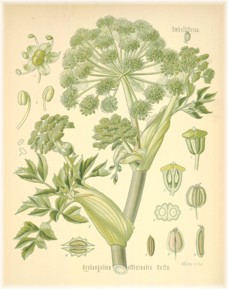Angelic Angelica
by Audrey Stallsmith

A confectioner of Yvetot had been intrusted with the tarts and sweets. . .at dessert he himself brought in a set dish that evoked loud cries of wonderment. To begin with, at its base there was a square of blue cardboard, representing a temple with porticoes, colonnades, and stucco statuettes all round, and in the niches constellations of gilt paper stars; then on the second stage was a dungeon of Savoy cake, surrounded by many fortifications in candied angelica, almonds, raisins, and quarters of oranges. . .
Madame Bovary--Gustave Flaubert
During the bubonic plague in the 1600's, an angel supposedly appeared to a monk in a dream to recommend a cure. The prescription was an herbal tea sweetened with treacle (molasses) and spiced with nutmeg.
The specified herb was also associated with the springtime festival celebrating Gabriel's announcement to Mary. And it sometimes bloomed on May 8, the day of Michael the Archangel. So Angelica archangelica became forever identified with the heavenly messengers for whom it was named.
Also known as "the root of the Holy Ghost," the plant purportedly protected against sorcery and other evils, including lust and drunkenness! Its presence in a woman's house or garden was enough to clear her of witchcraft imputations.
As with fennel, angelica's size may partially explain why it was viewed as a defender and why it stands for "inspiration" in the Language of Flowers. Its stiff hollow stalks, topped by umbels of greenish-yellow flowers, can grow over six feet tall. Since the herb dies after setting seed, usually in its second year, it is considered a biennial. But, if the seedpods are cut off, it may persist for another year or two.
The ancients ate peeled angelica stems raw, cooked, or candied, the latter often being added to fruitcakes. The herb also flavored liquors such as benedictine and chartreuse, as well as fish dishes and stewed fruits like rhubarb. The scent is pleasantly musky and the taste has been compared to celery with a hint of juniper berry.
Angelica has also treated about every disease imaginable. It was the chief ingredient in an early patent medicine called Carmelite water, which also contained lemon balm, coriander, and nutmeg. Angelica is especially recommended for colds, flu, lung ailments, and indigestion.
In The Green Pharmacy, James Duke touts the herb for heart problems such as angina and arrythmia. He reports that angelica and other members of the carrot family are rich in calcium channel blockers and anti-arrythmia compounds.
The Chinese have their own angelica, sinensis--also known as dong quai, which is second in popularity there only to ginseng. In fact the herb is sometimes known as "female ginseng," as it's used to treat a variety of feminine woes such as menopause and menstrual problems. There is also an American angelica called atropurpurea.
My references in this article, however, have been to the European variety, Angelica archangelica. Jethro Kloss cautions that diabetics and pregnant women should avoid ingesting the plant. But, "plagued" or not, the rest of us can feel free to try the heavenly prescription!
Image is from Köhler's Medizinal-Pflanzen, courtesy of the Missouri Botanical Garden Library.








